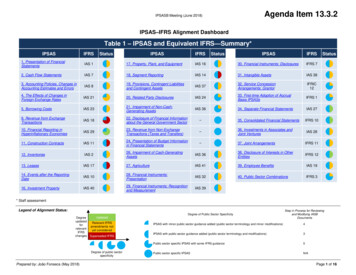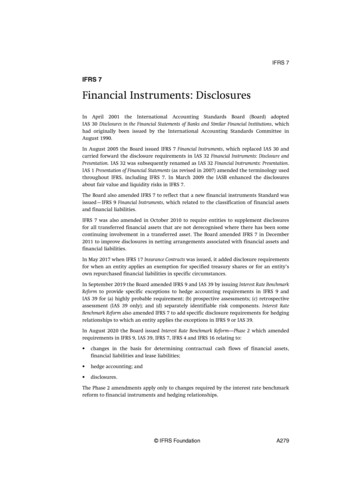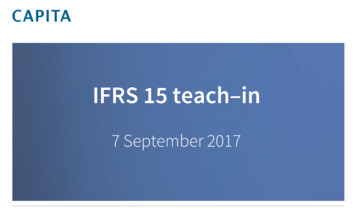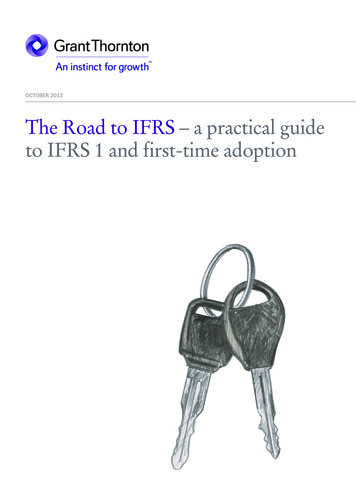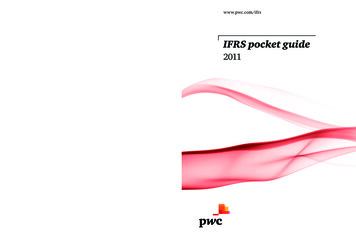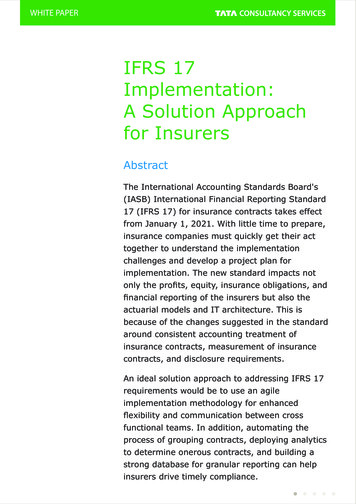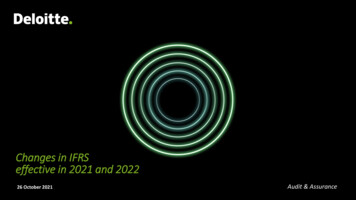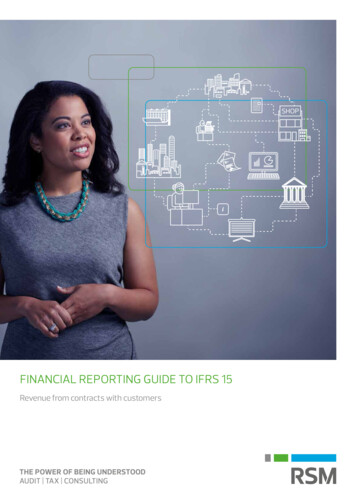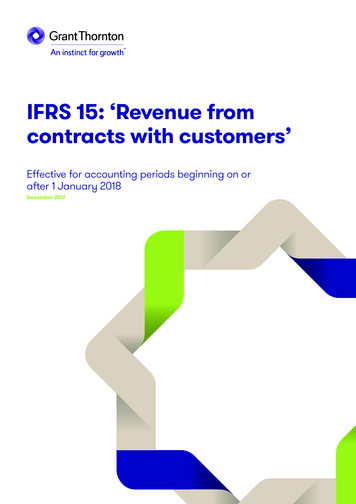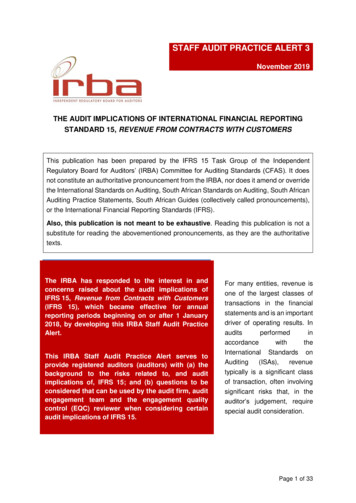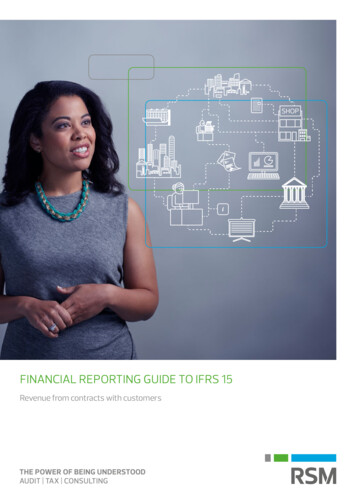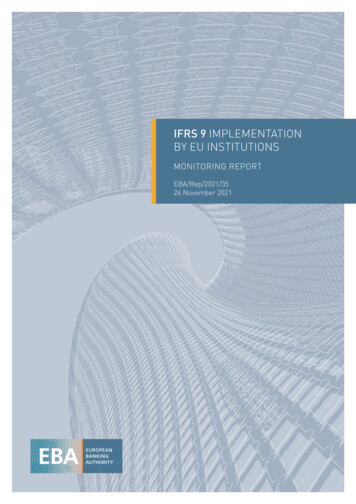
Transcription
IFRS 9 IMPLEMENTATIONBY EU INSTITUTIONSMONITORING REPORTEBA/Rep/2021/3524 November 2021
PDFISBN -NLuxembourg: Publications Office of the European Union, 2021 European Banking Authority, 2021Reproduction is authorised provided the source is acknowledged.For any use or reproduction of photos or other material that is not under the copyright of the European BankingAuthority, permission must be sought directly from the copyright holders.
IFRS 9 IMPLEMENTATIONBY EU INSTITUTIONSMONITORING REPORT
I F R S9M O N I TO R I N GR E P O R TContentsList of figures 5List of tables 8Abbreviations 91. Executive summary 10Part 1: Background and Objectives 161.1. Implementation of IFRS 9 in the EU and objective of the monitoring exercises 161.2. Methodology 181.2.1. Sample of banks181.2.2. Qualitative survey on IFRS 9 implementation191.3. Representativeness of the data collected for the quantitative analyses onLow Default Portfolios 191.4. Identification of outliers 211.5. Main caveat and limitations 21Part 2: Main findings and observations 232. Staging assessment: analyses on SICR and LCRE 232.1. Significant increase in credit risk assessment 252.2. Transfers to Stage 2 302.3. Alignment between the Definition of Default (DoD) and IFRS 9 exposures in Stage 3 362.4. SICR approach validation and key metrics used for monitoring 372.5. Application of the low credit risk exemption 392.6. Use of 12-month PD as a proxy for the lifetime PD 413. Expected Credit Loss Models 423.1. Type of Expected Credit Loss (ECL) models 433.2. Impact of COVID-19 on ECL models 443.3. Model limitations and use of overlays 453.3.1. General observations on the use of overlays453.3.2. Specific observations on the ECL overlays463.3.3. Approach used to determine COVID-19 overlays493.4. Other observations regarding ECL measurement in a COVID-19 scenario 503.5. Differences between Accounting and Prudential concepts (ECL vs EL) 534. IFRS 9 PD variability and robustness 564.1. Variability in the IFRS 9 PD and interplay with IRB estimates 574.2. Evolution of IFRS 9 PD with COVID-19 603
EUROPEANB A N K IN GA U T H O R IT Y4.3.Differences in the use of existing IRB models for IFRS 9 estimates634.3.1. Difference in the definition of default644.3.2. Difference in the risk differentiation644.3.3. Difference in the risk quantification654.4. Use of ECL overlays at the IFRS 9 PD level 685. Incorporation of forward-looking information (FLI)705.1. Variability in the impact from forward-looking information 5.1.1. Source of FLI and in consideration of public support measures735.1.2. Approaches used for taking into account the non-linearity in themacroeconomic scenarios745.1.3. Diverging practices introduced in the context of the pandemic795.1.4. Sensitiveness of IFRS 9 PD to the changes in the macroeconomic variables825.2. Interplay between IFRS 9 and internal stress test 835.3. Frequency in the update of forward-looking information 875.4. Use of sensitivity analyses 886. Classification and measurement896.1. Business model assessment 906.2. Solely payment of principal and interest (SPPI) test957. Recognition and derecognition977.1. Derecognition assessment 987.2. Write-offs policy 997.3. Presentation of interest income 8. Application of IFRS 9 Transitional Arrangements and other prudential observations 1011038.1. Application of IFRS 9 transitional arrangements 1048.2. Immovable property collateral valuation 107Part 3: Next steps and areas of further work 1099. Next steps and areas of further work1099.1. Follow-up work on the IFRS 9 benchmarking exercise 10. Annex47110911110.1. Annex 1: EBA publications and data collections on IFRS 9 11110.2. Annex 2: Information on the sample of institutions within the scope of theIFRS 9 benchmarking exercise 11210.3. Annex 3: Methodology to measure PD variability 11310.4. Annex 4: Kendal tau and correlation 11510.5. Annex 5: Table per country with detailed overview of the application ofIFRS 9 transitional arrangements 116
I F R S9M O N I TO R I N GR E P O R TList of FiguresFigure 1.Representativeness for each institution (exposure value)20Figure 2.Ratio between i) the exposure value of the facilities used for the purposeof the quantitative analyses on SICR and on the low credit risk exemptionand ii) the exposure value of the common counterparties submitted 21Figure 3.Limited implementation of a SICR collective assessment approach(IFRS 9 examples) 27Figure 4.Limited use of a top-down SICR collective assessment approach 27Figure 5.Transfers from Stage 1 to Stage 2 justified by SICR overlays 28Figure 6.Percentage of transfers from Stage 1 to Stage 2 justified by SICRoverlays per bank 28Figure 7.Share of institutions using top-down approach for collective assessmentand/or overlays 29Figure 8.Changes to the overall SICR approaches: discrimination of obligors andpublic support measures 30Figure 9.Total transfers from Stage 1 to Stage 2 30Figure 10. Total transfers from Stage 1 to Stage 2 for subgroups of institutions(December 2019 and December 2020) 31Figure 11. Comparison of the share of exposures classified in Stage 1 despite athreefold increase in PD since the origination 31Figure 12. Allocation of credit risk allowance per stage 34Figure 13. Allocation of on-balance-sheet items per stage 34Figure 14. Evolution of coverage ratio for all the stages of impairment (simple average) 35Figure 15. Non-performing exposures allocated to IFRS 9 Stage 3 37Figure 16. Transfers from S2 to S3 and transfers back from S3 to S2 37Figure 17. Key metrics to validate SICR assessment approach 38Figure 18. Consequences of the impact from the COVID-19 pandemic andeffectiveness tests performed on the staging process38Figure 19. Application of the LCRE by institutions in the sampleFigure 20. Number of institutions applying the LCRE per portfolio 40Figure 21. PD threshold associated with the LCRE for Stage 1 exposures 41Figure 22. Adjustments performed to ECL models 44Figure 23. COVID-19 impact on the final ECL amount 44Figure 24. Level at which manual adjustments/overlays have been considered 46Figure 25. Share of ECL associated with overlays by type of portfolio (December2019 vs June 2020) 47Figure 26. Large corporate: Share of ECL associated with ECL overlays (bothCOVID-19 and non-COVID-19 related) (December 20219 vs June 2020) 47Figure 27. Impact of ECL overlays per portfolio and types of overlays 485
EUROPEANB A N K IN GA U T H O R IT YFigure 28. Level of Stage 2 coverage ratios 49Figure 29. ECL overlays used as a response to COVID-19 based on internal stresstesting analyses 50Figure 30. ECL model modifications to reflect public support measures 50Figure 31. Treatment of government guarantees 51Figure 32. Future treatment of default and loss information in the historical databases 52Figure 33. Levels of IRB surplus and shortfall as of December 2019 and 2020(simple average) 54Figure 34. Ratio 12M ECL (IFRS 9) over EL (IRB) 55Figure 35. Variability in IFRS 9 12-month PD compared to the benchmark PD(December 2019 and June 2020) 57Figure 36. Evolution of the variability of PD IFRS 9 between December 2019 and June 2020 58Figure 37. Comparison of the variability of PD IFRS 9 and IRB PD in June 2020 59Figure 38. Large corporate: Variability in IFRS 9 and IRB 12-month PD (December2019 vs June 2020) 59Figure 39. Large corporate: Evolution in the IFRS 9 and IRB PD 12 months in the 1H 2020 61Figure 40. Large corporate: Evolution in the IFRS 9 and adoption of ECL COVID-19 overlays 61Figure 41. Large corporate: Comparison between the average IFRS 9 and IRB12-month PD (December 2019 vs June 2020) 62Figure 42. Large corporate: Comparison between the average IFRS 9 and IRB12-month PD (December 2020) 63Figure 43. Use of IRB models for determining the IFRS 9 PD in case of Low DefaultPortfolios 64Figure 44. PD concept used for the purpose of the ECL estimates 64Figure 45. Kendall Tau between PD IFRS 9 and PD IRB (June and December) 65Figure 46. Type of adjustments performed on the IRB model in the risk quantification 66Figure 47. Large corporate: Use of overlays/manual adjustments at the PD level 68Figure 48. Evolution in the IFRS 9 PD 12 Months for those institutions usingoverlays/manual adjustments 69Figure 49. Institutions revising their baseline and downward scenarios in a morepessimistic manner 72Figure 50. Impact from FLI incorporation into the final ECL number 73Figure 51. Sources used for macroeconomic forecast and consideration of theimpact of public measures 74Figure 52. Approach used for evaluating the range of possible outcomes in the ECL amount 756Figure 53. Changes in the range of scenarios and in their probability weights as aresponse to the pandemic 75Figure 54. Average weights assigned to the 3 macroeconomic scenarios (LDPs) 76
I F R S9M O N I TO R I N GFigure 55. Average weights assigned to the 3 macroeconomic scenarios (HDPs) 76Figure 56. Impact on the total ECL recognised in the reference period whenapplying 100% probability weight to most upward and downward scenarios 76Figure 57. Ratio between WA PD and PD baseline Box plot with 25th, 50th and 75thpercentiles (December 2019) 77Figure 58. Ratio between WA PD and PD baseline Box plot with 25th, 50th and 75thpercentiles (June 2020) 77Figure 59. Detailed forecasting period and reversion to long-term average 78Figure 60. Changes in GDP growth for those institutions applying smoothing factors(in red) in comparison to the other banks in the sample 79Figure 61. Example of institutions presenting an inversion in the severity of theforecast of the downward scenario 80Figure 62. Large corporate: Impact on ECL amount associated with COVID-19 overlays 80Figure 63. Examples of changes in the range of the IFRS 9 scenarios and in theirprobability weight for the sample of banks participating in the second adhoc exercise 81Figure 64. Sensitiveness in the IFRS 9 12-month PD to the GDP growth 82Figure 65. Current use of IFRS 9 macroeconomic scenarios for other purposes 85Figure 66. COVID-19 scenarios used for internal stress testing 86Figure 67. EBA stress-test scenarios vs IFRS 9 scenarios 86Figure 68. Internal stress-test scenarios vs IFRS 9 scenario 86Figure 69. Severity of scenarios: IFRS 9 vs internal ST 87Figure 70. Update of FLI used to calculate ECL 88Figure 71. Sensitivity analysis: risk factors vs impact on ECL 88R E P O R TFigure 72. Thresholds to assess ‘insignificant in value’ applied at the level of HTC portfolio 91Figure 73. Real sales of debt securities: 2018 to June 2020 92Figure 74. Assessment of ‘sales frequency’ 92Figure 75. Number of breaches of threshold in terms of frequency or volume of sales 93Figure 76. Identification of the increase in credit risk for sales which occurred dueto an increase in credit risk during the reference period for a subset ofcredit-impaired assets 93Figure 77. Definition and implementation of ‘close to maturity’ 94Figure 78. ‘Close to maturity’ concept – assessment whether the proceeds fromsales approximate the collection of the remaining contractual cash flows 94Figure 79. Type and number of reclassifications since the first application of IFRS 9 95Figure 80. Proportion of financial assets which require quantitative benchmark analysis 96Figure 81. Thresholds for assessing if the cash flows significantly different from thebenchmark cash-flows in each reporting period and cumulatively 967
EUROPEANB A N K IN GA U T H O R IT YFigure 82. Criteria used to assess whether or not the modification of financialassets leads to the derecognition of original exposure 98Figure 83. Types of other qualitative modifications 99Figure 84. Total write-offs 100Figure 85. Proportion of recoveries after write-offs 100Figure 86. P&L line where a correction is considered 101Figure 87. Policy on recognition of penalty interest related to Stage 3 exposures inthe statement of profit or loss 102Figure 88. Policy on recognition and presentation of the accrued interest related tonon-performing debt instruments measured at fair value through profit or loss 102Figure 89. Application of the IFRS 9 transitional arrangements as of December 2019and 2020 (EU level) 105Figure 90. CET1 impact of the application of IFRS 9 transitional arrangements pertype of approach (EU sample) presented in basis points 106Figure 91. Changes in the application of IFRS 9 transitional arrangements (EU level) 106Figure 92. Table per country with the approach selected by institutions as ofDecember 2020 (EU level) and percentage of institutions changing theirapproach during 2020 107Figure 93. Frequencies of revaluation of immovable property collateral for creditimpaired exposures 108Figure 94. Methodology for revaluation of immovable property collateral for creditimpaired exposures 108Figure 95. Timeline with EBA Publications and Data collections on IFRS 9 sinceNovember 2016 111List of Tables8Table 1.Sample of institutions participating in the second ad hoc exercise19Table 2.Key statistics on the representativeness for EAD as of December 2019 forthe analyses on IFRS 9 PD20Table 3.Impacts from financial covenants suspension53Table 4.Main differences between IFRS 9 PD and regulatory PD67Table 5.Representativeness of the sample of institutions within the scope of theIFRS 9 benchmarking exercise (EUR Bn)112Table 6.Example on the Kendall tau coefficient115
I F R S9M O N I TO R I N GR E P O R TAbbreviationsACamortised costBCBSBasel Committee on Banking Supervisionbpsbasis pointsCET1common equity tier 1COREPcommon reporting frameworkCRRCapital Requirements RegulationEADexposure at defaultEBAEuropean Banking AuthorityECLexpected credit lossEEAEuropean Economic AreaEUEuropean UnionFINREPfinancial reporting frameworkFVOCIfair value through other comprehensive incomeFVPLfair value through profit or lossHTChold to collectIAimpact assessmentIAS 39International Accounting Standard 39 – Financial Instruments: Recognition andMeasurementIASBInternational Accounting Standards BoardIFRS 9International Financial Reporting Standard 9 – Financial InstrumentsIRBinternal ratings-basedITSImplementing Technical StandardsLCRElow credit risk exemptionLDPlow-default portfolioLGDloss given defaultNPEnon-performing exposurePDprobability of defaultPOCIpurchased or originated credit-impairedQ&Asquestions and answersRWArisk-weighted assetSAstandardised approachSICRsignificant increase in credit risk9
EUROPEANB A N K IN GA U T H O R IT Y1. Executive summaryEBA continued to monitor and scrutinise theimplementation of IFRS 9 in the EU.Different practices observed between institutionswhich is something inherent to the flexibilityembedded in the IFRS 9 standard.Since the publication of its last report onthe first observations on the impact and implementation of International Financial Reporting Standard 9 ‘Financial Instruments’(IFRS 9) by EU institutions (1), and as communicated in its IFRS 9 roadmap (2), the EBAcontinued to monitor and scrutinise the implementation of IFRS 9 in the EU.In addition to the qualitative monitoring of theimplementation, from mid-2019, the EBA developed an IFRS 9 benchmarking exercise, building on its existing benchmarking exercises, inparticular in the area of credit risk, in order tointroduce the IFRS 9 accounting and modellingdimension into the global picture of the analysisof the risks and capital requirements.Furthermore, in line with the statement published in March 2020 (3), the EBA has conductedadditional activities with the aim of monitoringEU institutions’ practices in the context of theCOVID-19 pandemic, in order to better understand the impact of IFRS 9 on capital requirements, as well as the way banks are applyingjudgment in the assessment of the level of andchanges in the credit risk of their exposures.This report summarises the findings arisingfrom the EBA’s investigations since the publication of its last report in December 2018.These findings are meant to assist supervisors’ evaluation of the quality and consistencyof the ECL frameworks implemented by EUbanks, in order to contribute to a high-qualityand consistent application of the IFRS 9 standard. These findings will also be used by theEBA to continue its discussions on IFRS 9 implementation with banks, auditors and stan(1) EBA report on first observations on the impact and implementation of IFRS 9 by EU institutions.(2)EBA Roadmap for IFRS 9 deliverables, July 2019.( ) EBA Statement on the application of the prudentialframework regarding Default, Forbearance and IFRS 9 inlight of COVID-19 measures, March 2020.310dard-setters. As communicated when publishing the IFRS 9 roadmap, the benchmarkingexercise will be conducted under a mediumto-long-term perspective and the findings inthis report can certainly not be considered asbeing the final status of the reflections.Banks have generally made significant effortsto implement the IFRS 9 standards and adapttheir systems to the requirements. The high level of judgment embedded in the standard keep itopen to a wide variety of practices at this stage.No single practice appears to be a strong driverof the ultimate levels of provisioning. On top ofthe limited experience and history to date, theCOVID-19 pandemic has required some rapidadjustments to models that could not have beentested over a long period of time. Close monitoring and investigations from a regulatory andsupervisory perspective will hence be needed.Content of the reportThis report is structured in the followingmanner: Part 1 (Introduction) includes backgroundinformation on the EBA monitoring activities in the context of IFRS 9, incorporatingthe objectives of the analysis conducted. Part 2 (Main findings and observations) provides more information on the main findingsfrom this monitoring exercise, with specificreference to the practices observed in thecontext of the COVID-19 pandemic. Part 3 (Next steps) describes futureplanned EBA initiatives in the context ofthe IFRS 9 monitoring.Main findings and observationsThe main observations included in the reportdeal with the following aspects:A. Staging assessmentLimited changes observed in banks’ significantincrease in credit risk (SICR) approaches duringthe first half of 2020. The use of a SICR collectiveassessment or any other approach to timelycapture factors that would not be identified at anindividual level remains very limited.
I F R SWhen assessing the practices in place to determine whether a certain financial instrument experienced a significant increase incredit risk (SICR) and, as such, should betransferred to Stage 2, limited changes wereobserved in banks’ overall significant increase in credit risk assessments during thefirst half of 2020.The use of a collective SICR assessment isdefinitely lacking, while such collective SICRapproach can lead to relevant impacts interms of transfers to Stage 2. Under a scenario like the COVID-19 crisis, under whichsome relevant information was potentiallynot available at individual level, especially theuse of a top-down collective type of approachwould have been expected.Limited changes to the overall SICR assessment approaches applied as of June 2020,despite the need to accommodate practiceson the discrimination of the obligors underCOVID-19 support measures. SICR collectiveassessment continues not to be widely usedacross institutions and, instead, an individualassessment was often considered sufficientto adequately identify increases in the levelof credit risk.Based on the data collected, the lack of collective assessment, particularly a top-downapproach, does not seem to be justified by theapplication of alternative approaches with apotentially similar outcome as, for instance,SICR overlays or manual adjustments. This isa point of attention for regulators and supervisors.The impacts of the application of collectiveapproaches might be material in terms oftransfers to Stage 2 and similarly for SICRoverlays. Overall, institutions applying overlays and/or performing a SICR collective assessment reported, on average, a higher level of transfers during the analysed periods.9M O N I TO R I N Gthis approach, for a selected quantileof the distribution, mechanically leadsto higher relative thresholds than forless volatile portfolios. In any case, thecalibration of the SICR threshold wouldneed to be supported by sound evidencedemonstrating that the related quantitative threshold does not result in a delayin the Stage 2 transfers.There is also extensive use of the low creditrisk exemption for certain institutions. Different practices across EU banks as regardsthe PD level associated with an instrumentwith low credit risk will also require heightened supervisory scrutiny. Significantly highthresholds may result in a delay in the Stage 2transfers where this exemption is widely applied.As regards the implemented accounting andregulatory definition(s) of default, good alignment between the two of them continues tobe observed across institutions.B. Expected credit loss (ECL) modelsCOVID-19 pushed IFRS 9 models outside theirboundaries thereby increasing the use of overlaysleading to more divergence in terms of materialityof the impact in the final ECL amount.Almost all institutions use an EAD*PD*LGDapproach to measure ECL. Since the first application of IFRS 9, some adjustments wereperformed to the ECL models that appearedto be recalibration / significant changes forthe majority of the institutions. COVID-19pushed IFRS 9 models outside their boundaries thereby increasing the use of overlaysleading to more divergence in terms of materiality of the impact in the final ECL amount. a combination of absolute and relativethresholds with both criteria needing tobe met to trigger a transfer to Stage 2.In this regard, it is recalled that stagetransfer triggers defined in absoluteterms (either as an absolute probabilityof default (PD) level or an absolute PD increase) are generally not considered tobe in line with IFRS 9; orGoing forward, the use of overlays across EUinstitutions should be subject to continuedmonitoring, in order to investigate whetherand to what extent banks will adjust their ECLmodels in order to incorporate the effects ofoverlays or if some type of overlays will bemaintained, despite their expected temporarynature. In this regard, it is worth pointing outthat, as indicated in the EBA Guidelines onECL (4), adjustments to allowances are expected to be used as an interim solution andshould not be continuously used over the longterm. Finally, good governance measuresaround the application of overlays are crucial. SICR thresholds determined based ona ‘quantile approach’. Indeed, for portfolios with higher volatility in credit risk(4) Guidelines on credit institutions’ credit risk management practices and accounting for expected credit losses(EBA/GL/2017/06)Some other practices deserve further scrutiny from a supervisory perspective, dealingin particular with:R E P O R T11
EUROPEANB A N K IN GA U T H O R IT YWith regard to the materiality of impacts ofCOVID-19 on the levels of the ECL amount,significant diversity was observed across theinstitutions in the sample, with impacts ranging from negligible up to 50% or higher.The overlays that were being considered byinstitutions as of December 2019 remainedrelatively constant between this date andJune 2020. Those that were added on topduring the first half of 2020 relate almost exclusively to the COVID-19 pandemic. Overlayscan lead to a material impact in terms of thefinal ECL number and, as such, should beseen as a key area for regulatory and supervisory monitoring.As shown by an analysis of the coverageratios for Stage 2, the coverage levels arehigher for institutions with more than half ofportfolios subject to manual adjustment thanfor institutions applying adjustments for lessthan half of portfolios.Given the unprecedented circumstances of theCOVID-19 crisis, the application of temporaryoverlays was necessary in cases where themodels could not cope with the specificitiesof the situation. However, it is paramount thatthese overlays are associated with appropriategovernance measures and that supervisorshave a good understanding of the methodological features underlying their design and application to ensure that the credit risk is appropriately reflected in the final impairment metrics.Most of the institutions did not rely on internal stress-testing analyses to determine theoverlays to be applied when measuring ECL.Effects of the COVID-19 crisis are modelled ina very heterogeneous manner. Also, some diversity in practices was observed as regardsthe treatment of government guarantees.C. IFRS 9 PD variability and robustnessThe IFRS 9 12M PD estimates and variabilitygenerally increased during the pandemic, as aresult of the incorporation of the forward lookinginformation and their point in time nature, whilethe IRB PDs remained comparatively relativelystable.The data collected allow for a direct comparison of the bank’s estimates for a set of common counterparties. As such, it is possible todisaggregate the risk-based variability (different PDs due to different counterparties)from the practice-based one (different PDsfor the same counterparties).12The practice-based variability in the IFRS 912-month PD significantly increased in thecontext of the COVID-19 pandemic, while theIRB estimates remained substantially stable.This pattern can be explained by the higherincrease in the IFRS 9 12-month PD estimates observed in the first half of 2020, as aresult of the more point-in-time nature of theIFRS 9 PD and the incorporation of forward-looking information (FLI). Indeed, foralmost all the institutions in the sample, theincrease in the IFRS 9 PD was larger thanthe IRB PD.When assessing the practices adopted by institutions presenting a lower increase in theIFRS 9 12-month PD, it was observed that inthe first half of 2020, some of them introduced certain adjustments (e.g. ‘smoothingfactors’) to the macroeconomic variables underlying the IFRS 9 scenarios. Other areas ofscrutiny relate to cases of institutions explicitly mentioning not having revised the IFRS 9scenarios or showing a relative increase inthe IFRS 9 PD similar to the one observed onthe regulatory PD, raising concerns on thelimited impact of forward-looking information on the IFRS 9 estimates.Significant differences have been observedin the concept used for modelling the IFRS 9PD and in the nature of adjustments appliedwhen departing from the regulatory estimates to determine the IFRS 9 PD. The highdegree of judgement involved in the estimate of the IFRS 9 risk parameters and thelack of supervisory validation for the IFRS 9ECL models increase the importance forcompetent authorities to gather a thoroughunderstanding of the IFRS 9 modelling practices, including the degree of leverage onthe data and information used for regulatorypurposes and of the factors that affect thevariability in the IFRS 9 estimates in comparison to those used for regulatory purposes. In particular: Generally, those institutions for which alower increase in the IFRS 9 12-monthPD was observed introduced COVID-19overlays at the ECL level. Nevertheless, in many cases, the impact of theseoverlays was not particularly relevant,raising some interrogations on whethersuch overlays could effectively compensate for the lack of reactivity observed inthe IFRS 9 12-month PD. Cases wherethe low increase in the PD has not beencompensated for by the use of overlaysrepresent an area of further scrutiny forsupervisors;
I F R S The higher increase in the IFRS 912-month PD observed in 2020 also affected the interplay between the IFRS 9and IRB PD. Indeed, in June 2020, morethan half of the banks in the sample ofthe quantitative analyses presented anaverage IFRS 9 12-month PD higherthan the IRB PD for the Large corporate exposure class. However, the datacollected as of December 2020 seem toindicate that the interplay between theIFRS 9 12-month PD and the IRB PD isgoing to come back to a situation preCOVID-19.D. Incorporation of forward-lookinginformation Despite the changes introduced as aresponse to the COVID-19 crisis (in particular to introduce additional and morepessimistic scenarios or assign a higherprobability weight to the original downward scenarios), the IFRS 9 12-month PDestimates are still significantly driven bythe assumptions underlying the baseline scenario, raising concerns aboutthe limited degree of the impact fromthe non-linearity in the multiple macroeconomic scenarios embedded in banks’models.M O N I TO R I N G Sometimes a single scenario without anyadjustment/overlay to reflect non-linearity effects is used. This practice wouldnot meet the objective of IFRS 9 unlessthere is a linear relationship between thedifferent forward-looking scenarios andthe associated credit losses. In other cases, extremely long forecasting periods or approaches involving areversion to the mean over a long timeframe are used, raising some concernson whether the information used for theIFRS 9 scenarios can be reasonably supported or considered representative forthe purpose of the ECL measurement. In the context of the pandemic, somepractices that were aimed at avoiding excessive variability in the IFRS 9 estimatescould lead, in turn, to more through-thecycle ECL estimates compared to theexpectations from the accounting standard or to minimise the impact on theECL measurement stemming from thenon-linearity in the IFRS 9 macroeconomic scenarios. The interplay between IFRS 9 and internal stress-testing scenarios with reference, in particular, to the changes introduced during the pandemic remains anarea to further monitor.The impact on ECL stemming from theincorporation of forward looking informationincreased during the pandemic and variedsignificantly across institutions. Some practiceshave been observed that deserve further scrutinyfrom supervisors.The impact on ECL stemming from the incorporation of FLI, whilst increased duringthe pandemic, varied
Source of FLI and in consideration of public support measures 73 5.1.2. Approaches used for taking into account the non-linearity in the macroeconomic scenarios 74 5.1.3. Diverging practices introduced in the context of the pandemic 79 5.1.4. Sensitiveness of IFRS 9 PD to the changes in the macroeconomic variables 82 5.2. Interplay between IFRS 9 and internal stress test 83 5.3. Frequency in .

